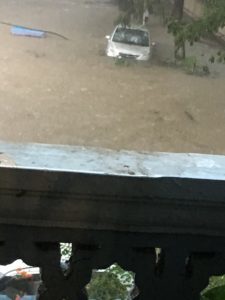
Dear reader:
You must have read about the very heavy rains, which lashed Mumbai on August 29, 2017. About 12 inches (30cm) of rainwater pounded the city for about 6 hours and that too during the busiest hours.
That morning at about 6:00 am I made the mistake of choosing to play golf at the Chembur course despite steady but mild rain.
I reached the course to find that a group of four golf addicts had given up and asked me if I was going to practice, when I replied that I planned to play their surprised look should have warned me, but I disregarded them and went on to play, happy that I had the whole course to myself. I took many “mulligans” (extra shots) and practiced putting on each of the greens. Finally, after sloshing around for 14 holes I finally gave up (also after I hit my third ball in the water). Incidentally, from golf point of view I played quite well having hit four pars in 14 holes and quite a few bogies (mulligans notwithstanding).

Fortunately, I quit in the nick of time, as the rain picked up its intensity. I left the Chembur Golf course by about 11:00am. I took the expressway and headed for Wadala. At that time Ranjana (my wife) warned me of the heavy rains and possible flooding enroute. I dismissed her fears nonchalantly, as I was not going towards Lower Parel and other low lying areas of Mumbai, which typically get water logged during heavy rains. After breezing along the expressway my feelings of well being were soon to change. To reach Dadar from Wadala I had to cross a railway bridge. Normally it should have taken 5 minutes, but it took almost two hours. I later learned that the heaviest rainfall was at Wadala and I was at the center. By that time I also began to worry about my dropping sugar level as I had not eaten enough food. I was half contemplating pulling over and requesting some of the pavement dwellers for some food.
When I reached the end of the bridge, I saw that the reason for the delay and that was the road was under two feet of water and a couple of trees were also uprooted making the journey even more risky.
As I approached the water logged road I had to decide risking it or parking the car on the side. I noticed some vehicles smaller than mine making it across (about 150 meters). Several good Samaritans were on either side directing and guiding the motorists. They were self appointed and probably lived in the shanties, which were on either side of the road. They were very efficient and even counseled the drivers to drive on the center of the road where the water was shallower and also not to take the foot of the accelerator (as water could stall the engine if it entered the compartment). Now, if you drive a car with a stick shift then one can use the clutch pedal and raise the engine rpms. But you cannot do that with my car, which had an automatic transmission. Nevertheless, I put my faith in German engineering and gingerly entered the water. I made it to the other side and had quite a few anxious moments, especially towards the end as the car began to shudder. I still cannot figure the shuddering as brakes were fine and the engine was smooth. I think perhaps the car began to strain towards the end of the water logged road as it sloped upwards and perhaps the wheels were slipping.
Anyway, I was quite relieved to cross this hurdle not realizing that bigger challenges lay ahead near Dadar. To those not familiar with Dadar, I have to mention that it is one busiest and lowest lying areas of Mumbai. I had to cross Dadar and go across to the century old Tilak bridge to reach the higher level areas to reach my apartment in Prabhadevi.
Now even during the best of times it takes about 10 to 30 minutes to negotiate the Dadar/Tilak bridge bottleneck. With this downpour and water logging the delays could increase exponentially.
After making several attempts cross over to Prabhadevi I gave up and parked my car on the approach to a flyover near Dadar. Many others had also done the same. My next task was to get some food as I was soon reaching low sugar levels. I found some enterprising vendor was selling fast food snacks, though not too fond of the same I went in search for the vendor only to find that he was sold out. I even thought of asking a family for some biscuits which they were giving to their youngsters. Somehow my pride prevailed and I went in search for some fast food joint near the Ruia College. Whilst wading through the rain waters I suddenly remembered that our good friends (Shyam and Shubha Joshi) lived within walking distance.
I was lucky to get hold of Shubha (Shyam was stuck at Parel for several hours in his car whilst returning home). She immediately welcomed me and prepared a quick lunch. Shyam was also able to drive back as he was very familiar with the back roads of Parel.
By then (around 4:30pm) the rain was at its peak and so was the high tide. I took a photo of a half submerged car in the opposite compound. Ranjana kept providing updates and prospects did not look good. However, by 6:30 the rain had subsided and the water level in the building compound had gone down by a few inches. I consulted Google and found that low tide was at 11:30pm. I therefore reckoned that if I were to venture out by 8:00pm the water levels would have dropped further and with luck I had a chance to drive back, or at least walk home (about 40 minutes away). Even though Shyam and Shubha said I was more than welcome to spend the night I decided to take my chance and leave for home.
At the Dadar flyover the same good Samaritans were there directing traffic and helping stranded citizens with information.
One of them recognized me and told me that I could make a break for it as water levels were lower and traffic was moving. With great difficulty I managed to reverse my car down the flyover slope to merge with the main road. I managed the half-kilometer stretch, which was under one foot (about 30cm) water. There was only one other car coming the wrong way and two guys pushing stalled motor bikes. All this did not auger well. Nevertheless I persisted and heaved a sigh of relief when I approached the famous Dadar TT circle as the water was only about a couple of inches deep. My relief was short lived as the approach to the Tilak bridge was under two feet water. I saw a bus lurching in the water in front of me and I could barely see the tires. However some Samaritan waved me to proceed, which I did with extreme caution. Some how I managed to cross the flooded approach to the bridge and within ten minutes was at home enjoying a nice whiskey.
Now the reason for this story is not to regale you with my foolishness or luck, but to pay tribute to the real heroes of Mumbai, the gutsy Mumbaikers who are able to take many disasters in their stride. I saw so many office persons trudging back home in the rain, some alone, some with friends, and other couples using the rain as an excuse to huddle close together. Street urchins were seen frolicking in the water, using the flooded streets as huge swimming pool.
People were hazarding knee-deep water to help strangers push stalled vehicles to safer and drier ground. Scores of volunteers came out of their dilapidated shanties to help commuters and well off motorcar owners. I wondered how economically better off citizens sitting in the comfort of their air conditioned cars would stop and help someone in similar difficulties. How many of us just crane our necks to see the scene of an accident, but do not stop to try and help.
So many times we drive past the shanties, which run along highways and wonder how and when the authorities will remove the ”eyesores”. Do we give a thought as to how they manage a living on the roadside? Yesterday, when I was in a difficult situation stranded in my dry and comfortable car, I thought that if my sugar levels went low and I became hypo glycemic I would have no option but to stop by the road dwellers and ask for some food. I am sure that had I done so, then they would have readily helped. Yet when we do not need them we look at them with disdain or look through them.
Do we know where our domestic help live and how they manage such storms? Perhaps the same caddies who carry our heavy golf bag on the course live in such shanties. The same caddy that advises us on the nature of the putting green whether it is fast or slow, is there a slope, how will the ball turn. A self-taught expertise acquired over years. They can tell you how far is the green from where you are planning to hit the ball, which way does the wind blow, which iron to select etc. How some of them have an uncanny knack of finding the ball when it is hit in the rough or the water. How, without asking they will search for the ball in the water at the risk of slipping in.
But apart from paying a fee and some breakfast tip do we care how they live? How many of us will help them when they are hurt but a stray ball. These are some of the thoughts, which come to my mind when I think of the past 24 hours.
The irony is that my car is fine the sun is shining, the rain has stopped, my kit is dry, my shoes are also clean and dry, and am itching to go and play, but of course the golf courses are water logged and closed, my car mechanic has his garage full of stalled and ruined cars.
Have I learned my lesson? Under similar circumstances will I venture to play golf? Who knows? But one thing is certain – Ranjana will hide the cars keys!!
Jayant V Pendharkar
Jayant (TCS 1971-1979 and 1996-2010) is the Secretary and a Governing Body member of Fortess. Connect with him here.